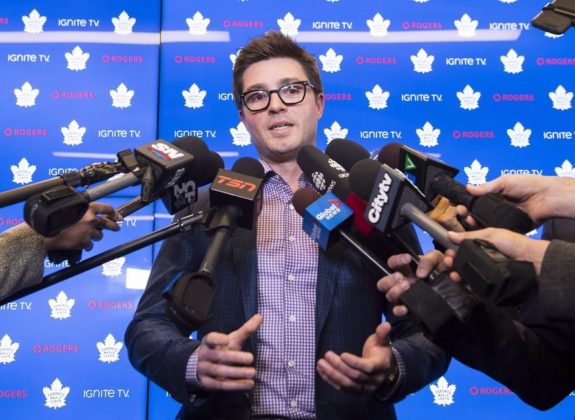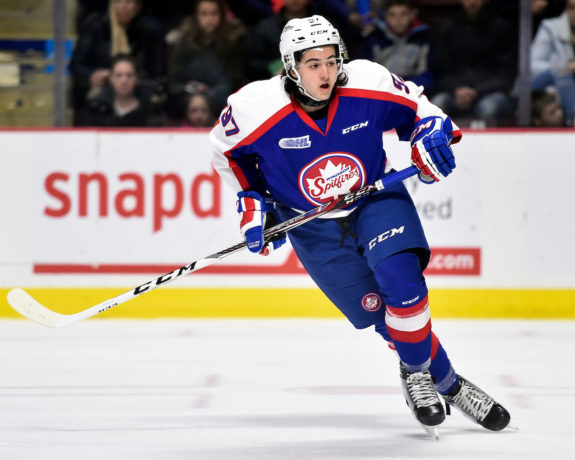
The Toronto Maple Leafs will be without a first-round pick at this Friday’s NHL Entry Draft, but that doesn’t mean they won’t be able to acquire high-end talent. The team’s first selection will come in the second round at 53rd overall and from past experience, we know that there will be plenty of hidden gems still on the board. The task for general manager Kyle Dubas and his staff will be to uncover some of those gems with their seven picks on Saturday.

With that in mind, the Maple Leafs should have two main strategies going into this year’s draft.
Draft For Skill
The Maple Leafs need to draft skill above all else. It may sound obvious, but opting for skill over size is still not a consistent practice in the NHL.
It was only six years ago that Toronto selected 6-foot-5 Frederik Gauthier at 21st overall, leaving players like Shea Theodore and Andre Burakovsky to be taken just a few picks later. Two years before that, in 2011, management used their 22nd overall pick on Tyler Biggs, who went on to have a relatively successful career in the ECHL. They also took 6-foot-4 Russian winger Yegor Korshkov at 31st overall in 2016, while 5-foot-7 Alex DeBrincat was taken 39th. DeBrincat scored 41 goals this season while Korshkov has yet to play a game in the NHL.

The issue of drafting size is not just a Leafs phenomenon; it is still practiced by a large percentage of the league. On the other hand, look at a team like the Tampa Bay Lightning who have built their roster largely by drafting skilled players regardless of size. This is the philosophy that the Maple Leafs should employ and with Dubas at the helm, it seems likely that they’ll value skill above all else moving forward.
Draft For Need
The old adage says, you should always draft the best player available regardless of position or organizational need. High-end talent is the most valuable asset in the NHL and once you have that, you can either build around it or use it to trade for other valuable pieces.
This philosophy applies to first-round draft picks, but when you get into the second round it becomes difficult, if not impossible, to discern between players of similar talent levels. This is why you’ll never see two identical draft rankings after the first 10-15 picks or so. One analyst may have a certain player at 30 while another may have that same player at 50 or 60 – it’s the unpredictable nature of the draft.
When there’s no such thing as selecting the “best player available” anymore, it becomes more acceptable to draft based on position, especially when you believe that you can develop that player to fit your organizational needs. In terms of their NHL roster and organizational depth, the Maple Leafs are particularly shallow at centre, left wing, and right defence. Don’t be surprised if they throw most of their darts at those positions this weekend.
What Can You Get With a Second-Round Pick?
What kind of player can the Maple Leafs expect to find with their 53rd overall pick?
Elite talent is generally found in the first 10-15 picks of any given draft, but it’s the teams that can hit on the later picks that usually boast deeper lineups. According to a study from TSN, 44 percent of second-round picks will become “successful NHLers” with at least 50 career games. While the odds are somewhat stacked against Toronto in terms of finding an impact player, there are plenty of recent examples of legitimate NHLers selected around 53rd overall.
Recent Picks Around 53rd Overall
I scoured the results of each draft since 2010 and found a number of impact or even elite players that were selected right around 53rd overall:
- Nashville Predators selected Samuel Girard at 47th in 2016
- Calgary Flames selected Rasmus Andersson at 53rd in 2015
- St. Louis Blues selected Vince Dunn at 56th in 2015
- Anaheim Ducks selected Brandon Montour at 55th in 2014
- Washington Capitals selected Madison Bowey at 53rd in 2013
- New Jersey Devils selected Damon Severson at 60th in 2012
- Ducks selected William Karlsson at 53rd in 2011
- Tampa Bay Lightning selected Nikita Kucherov at 58th in 2011
- Minnesota Wild selected Jason Zucker at 59th in 2010

Of course, it’s important to remember that these picks are all outliers: you can’t expect to find a Kucherov or Zucker in the second round. However, it does illustrate the fact that high-end talent is always available; it’s just a matter of good scouting and valuing the right attributes.
Toronto’s History of Second-Round Picks
I also looked at Toronto’s recent history in the second round over the last few years. They haven’t drafted anyone who’s evolved into a star or even a successful NHLer just yet, but each player on the list has potential.

- Sean Durzi (RD) at 52nd in 2018
- Eemeli Rasanen (RD) at 59th in 2017
- Carl Grundstrom (LW) at 57th in 2016
- Jeremy Bracco (RW) at 61st in 2015
Possible Targets
With so many options, it’s nearly impossible to predict who the Maple Leafs might draft at 53rd overall, but if we add up all the elements, we can reach a rough estimation: Assuming they follow the philosophies of drafting for skill and need, they’ll be looking for a talented centre, left winger, or right-handed defenceman.
Referencing the 2019 draft rankings from THW’s very own Ryan Pike, here are a few players that would fit the Maple Leafs’ needs.
Anttoni Honka
Ranked 34th overall by Pike, Honka would be considered a best-case scenario if he fell to the Leafs. The right-handed Finnish defenceman is slightly undersized at 5-foot-10 and 176 pounds but possesses exceptional skating, puck-handling, and overall offensive upside. According to Pike, Honka, “has the skillset of a top-two rounder, but his lack of size and commitment to playing a 200-foot game may land him somewhere in the third or fourth round.”
Related: Anttoni Honka’s THW Draft Profile
He’s the perfect candidate for a team like the Maple Leafs if they want to take a swing on a high-risk, high-reward prospect. Honka bears many similarities to 2017 first-round pick Timothy Liljegren, and we’ve seen how much Liljegren has developed his overall game since joining the Marlies.
Billy Constantinou
Constantinou is another wild card, which is par for the course when drafting outside of the first round. He’s a right-handed defenceman with decent size at 6-feet and 185 pounds. He plays a high-octane game, often rushing the puck up the ice and creating offence for his team. Constantinou’s main drawback is his decision-making on defence: he’s often out of position due to over-aggressive plays or a lack of awareness. Pike ranks him at 48th for this year’s draft.
His 2018-19 campaign was a tale of two season: He started off hot with the Niagara Ice Dogs, tallying 15 points in 22 games, but after being traded to the last place Kingston Frontenacs his offence trailed off with just 18 points in 44 games. Constantinou’s raw skill is still there, and he’ll be an intriguing pickup for the team that drafts him.
Nikita Alexandrov
Alexandrov is 6-feet and 185 pounds, described as a reliable two-way centre with offensive potential. He showed a few flashes of offensive brilliance with his heavy shot and creative passing, although those moments were often followed by dry spells. He finished the season with 27 goals and 61 points for the Charlottetown Islanders of the Quebec Major Junior Hockey League. Pike ranks him at 73rd, although Corey Pronman has Alexandrov at 43rd.
Patrik Puistola
Puistola is probably one of the most exciting offensive players that could fall to the second round. Ranked 41st on Pike’s list, it’s unlikely that he falls all the way to 53rd but if he does, the Maple Leafs should be sprinting up to the podium.
Related: Patrik Puistola’s THW Draft Profile
He has decent size at 6-feet, 175 pounds, and is considered one of the best puck-handlers in the draft. Along with his silky smooth hands, Puistola’s highly competitive and fearless in his attack on the opposition’s net. His most notable weakness is his skating, as he lacks quickness.
Puistola had an up and down season, playing in three different Finnish leagues. He tallied 11 goals and 22 points with Tappara U20 of the Jr. A SM-liiga, and was then called up to Liiga where he struggled, with just one assist in 16 games. The crafty winger found his confidence again after moving down to the second men’s division, the Mestis, where he scored 15 goals and 26 points in 22 games for LeKi.
Honourable Mentions
Regardless of what the Maple Leafs want to do with their second-round selection, there will still be plenty of talent to choose from at 53. For a contending team with well-documented salary cap issues, they’ll need to hit on some of their late-round picks if they want to remain competitive for years to come.
Draft info and player stats from and THW’s draft rankings and HockeyDB